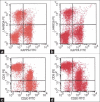Basics of cytology
- PMID: 23210005
- PMCID: PMC3507055
- DOI: 10.4103/2231-0770.83719
Basics of cytology
Abstract
This overview is intended to give a general outline about the basics of Cytopathology. This is a field that is gaining tremendous momentum all over the world due to its speed, accuracy and cost effectiveness. This review will include a brief description about the history of cytology from its inception followed by recent developments. Discussion about the different types of specimens, whether exfoliative or aspiration will be presented with explanation of its rule as a screening and diagnostic test. A brief description of the indications, utilization, sensitivity, specificity, cost effectiveness, speed and accuracy will be carried out. The role that cytopathology plays in early detection of cancer will be emphasized. The ability to provide all types of ancillary studies necessary to make specific diagnosis that will dictate treatment protocols will be demonstrated. A brief description of the general rules of cytomorphology differentiating benign from malignant will be presented. Emphasis on communication between clinicians and pathologist will be underscored. The limitations and potential problems in the form of false positive and false negative will be briefly discussed. Few representative examples will be shown. A brief description of the different techniques in performing fine needle aspirations will be presented. General recommendation for the safest methods and hints to enhance the sensitivity of different sample procurement will be given. It is hoped that this review will benefit all practicing clinicians that may face certain diagnostic challenges requiring the use of cytological material.
Keywords: Cytology; fine needle aspiration.
Conflict of interest statement
Figures






Similar articles
-
Real-time ultrasound elastography in the diagnosis of newly identified thyroid nodules in adults: the ElaTION RCT.Health Technol Assess. 2024 Aug;28(46):1-51. doi: 10.3310/PLEQ4874. Health Technol Assess. 2024. PMID: 39252469 Free PMC article. Clinical Trial.
-
Endocrine and neuroendocrine cytopathology.Minerva Endocrinol. 2018 Sep;43(3):294-304. doi: 10.23736/S0391-1977.17.02744-4. Epub 2017 Sep 25. Minerva Endocrinol. 2018. PMID: 28949123 Review.
-
Pitfalls in Lymph Node Fine Needle Aspiration Cytology.Acta Cytol. 2024;68(3):260-280. doi: 10.1159/000535906. Epub 2023 Dec 20. Acta Cytol. 2024. PMID: 38118434 Free PMC article. Review.
-
Real-World Diagnostic Accuracy of the On-Site Cytopathology Advance Report (OSCAR) Procedure Performed in a Multidisciplinary One-Stop Breast Clinic.Cancers (Basel). 2023 Oct 13;15(20):4967. doi: 10.3390/cancers15204967. Cancers (Basel). 2023. PMID: 37894334 Free PMC article.
-
Overcoming Pitfalls in Breast Fine-Needle Aspiration Cytology: A Practical Review.Acta Cytol. 2024;68(3):206-218. doi: 10.1159/000539692. Epub 2024 Jun 11. Acta Cytol. 2024. PMID: 38861943 Review.
Cited by
-
Cytology Smears: An Enhanced Alternative Method for Colorectal Cancer pN Stage-A Multicentre Study.Cancers (Basel). 2022 Dec 9;14(24):6072. doi: 10.3390/cancers14246072. Cancers (Basel). 2022. PMID: 36551559 Free PMC article.
-
Role of Scrape Cytology as an Adjunct to Fine Needle Aspiration Cytology in Diagnosis of Thyroid Lesions.J Clin Diagn Res. 2016 Oct;10(10):EC13-EC17. doi: 10.7860/JCDR/2016/21929.8732. Epub 2016 Oct 1. J Clin Diagn Res. 2016. PMID: 27891344 Free PMC article.
-
Computational 3D histological phenotyping of whole zebrafish by X-ray histotomography.Elife. 2019 May 7;8:e44898. doi: 10.7554/eLife.44898. Elife. 2019. PMID: 31063133 Free PMC article.
-
Deep learning-based identification of esophageal cancer subtypes through analysis of high-resolution histopathology images.Front Mol Biosci. 2024 Mar 19;11:1346242. doi: 10.3389/fmolb.2024.1346242. eCollection 2024. Front Mol Biosci. 2024. PMID: 38567100 Free PMC article.
-
Cytological Evaluation of Palpebral Lesions: An Insight into its Limitations Aided with Histopathological Corroboration.J Microsc Ultrastruct. 2020 Nov 9;9(1):12-17. doi: 10.4103/JMAU.JMAU_58_19. eCollection 2021 Jan-Mar. J Microsc Ultrastruct. 2020. PMID: 33850707 Free PMC article.
References
-
- Frable WJ. Fine-needle aspiration biopsy: A review. Hum Pathol. 1983;14:9–28. - PubMed
-
- Frable WJ. Integration of surgical and cytopathology: A historical perspective. Diagn Cytopathol. 1995;13:375–8. - PubMed
-
- Demay RM. The Art and Science of Cytopathology. 1st ed 1996.
-
- Cibas ES, Ducatman BS. Cytology: Diagnostic Principles and Clinical Correlates. 2nd ed 2003.
-
- Geisinger KR, Stanley MW, Raab SS, Silverman JF, Abati A. Modern Cytopathology. 1st ed 2003.
LinkOut - more resources
Full Text Sources

